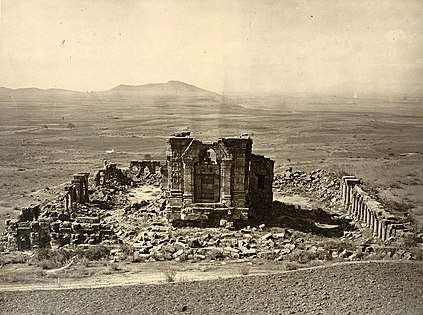Sikandar Shah Miri
Sikandar Shah Miri better known as Sikandar Butshikan ("Sikandar the Iconoclast"),[1] was the sixth sultan of the Shah Miri dynasty of Kashmir. He ruled the kingdom from 1389 to 1413 and is criticised for his strenuous efforts to forcefully convert the Hindus of Kashmir to Islam.[2]
| Sikandar | |||||
|---|---|---|---|---|---|
| Sultan of Kashmir | |||||
| 6th Sultan of the Shah Mir Sultanate | |||||
| Reign | 1389–1413 CE | ||||
| Coronation | 1389 | ||||
| Predecessor | Qutub-ud-Din | ||||
| Successor | Ali Shah | ||||
| Born | 1353 | ||||
| Died | 1413 | ||||
| |||||
| House | Shah Miri dynasty | ||||
| Religion | Sunni Islam | ||||
Rule
Persecution of Hindus
He is remembered by Hindus for perpetrating violence and torture upon his non-Muslim subjects in a bid to make them convert to Islam. It was under the influence of the Sufi extremist, Mir Mohammad Hamadani, that he committed atrocities against non-Muslims in his lands. Large numbers of Hindus converted, fled, or were brutally tortured and killed for refusal to convert during his reign.[2]

Sikandar won the sobriquet of but-shikan or idol-breaker, due to his actions related to the desecration and destruction of numerous temples, chaityas, viharas, shrines, hermitages, and other holy places of the Hindus and Buddhists. He banned dance, drama, music, iconography and such other religious, cultural or aesthetic activities of the Hindus and Buddhists, and classified them as heretical and un-Islamic. He forbade the Hindus to apply a tilak mark on their foreheads. He did not permit them to pray and worship, blow a conch shell or even to toll a bell. So unspeakable was Sikandar's tyranny that he even stopped Hindus and Buddhists from cremating their dead and compelled them to bury the bodies using Muslim rituals. He imposed the Jizya, a poll-tax to be paid by non-Muslims living as subjects in a Muslim state, and the levy was a heavy one: each non-Muslim (mostly Hindus) was required to pay an annual tax of four tolas of silver. [2]
Islamization of Kashmir
During the Shah Miri dynasty, Islam was violently enforced on the ethnic Hindu population of Kashmir and his rule has been considered controversial by several scholars due to his hateful, violent, non-accommodating, and non-secular policies in Kashmir. In consonance with the customs in Delhi and elsewhere, Sikandar created the office of Sheikh-ul-Islam and more important, decided that the Islamic law should be valid instead of the traditional law. But, as in other places, that may have been restricted mainly to the personal law.
It was during Sikander's reign that a wave of Sufi preachers headed by Mir Muhammad Hamadani (1372–1450) arrived in Kashmir in 1393. It is possibly under Hamadani's influence that Sultan Sikandar implemented an orthodox religious policy. The selling of wine, dancing of women, music and gambling were prohibited. The non-Mulsims had to pay jizya, and were forbidden to display religious symbols like wearing tilak. The Kashmiri chronicler Jonaraja writes:
"The good fortune of the subjects left them and the king forgot his kingly duties and took delight, day and night, in breaking images.[3]
He [Sikander] prohibited all types of frugal games. Nobody dared commit acts which were prohibited by the Sharia. The Sultãn was constantly busy in annihilating Hindus and destroyed most of the temples.[4]
He strived to destroy the idols of the infidels. He demolished the famous temple of Mahãdeva at Bahrãre. The temple was dug out from its foundations and the hole (that remained) reached the water level. Another temple at Jagdar was also demolished. Rãjã Alamãdat had got a big temple constructed at Sinpur. (...) The temple was destroyed [by Sikander].[5] Sikander burnt all books the same wise as fire burns hay. All the scintillating works faced destruction in the same manner that lotus flowers face with the onset of frosty winter."[6]
References
- M. K. Kaw (2004). Kashmir and Its People: Studies in the Evolution of Kashmiri Society. APH Publishing. pp. 108–. ISBN 978-81-7648-537-1.
- Kaw, K.; Kashmir Education, Culture, and Science Society (2004). Kashmir and Its People: Studies in the Evolution of Kashmiri Society. A.P.H. Publishing Corporation. ISBN 9788176485371. Retrieved 7 July 2015.CS1 maint: multiple names: authors list (link)
- Baloch, N. A.; Rafiqi, A. Q. (1998), "The Regions of Sind, Baluchistan, Multan and Kashmir" (PDF), in M. S. Asimov; C. E. Bosworth (eds.), History of Civilizations of Central Asia, Vol. IV, Part 1 — The age of achievement: A.D. 750 to the end of the fifteenth century — The historical, social and economic setting, UNESCO, p. 316, ISBN 978-92-3-103467-1
- Haidar Malik Chãdurãh: Tãrîkh-i-Kashmîr; edited and translated into English by Razia Bano, Delhi, 1991, p. 55.
- Khwãjah Nizãmu'd-Dîn Ahmad bin Muhammad Muqîm al-Harbî: Tabqãt-i-Akbarî translated by B. De, Calcutta, 1973
- Srivara, Zaina Rajtarangini
| Wikiquote has quotations related to: Sikandar Shah Miri |